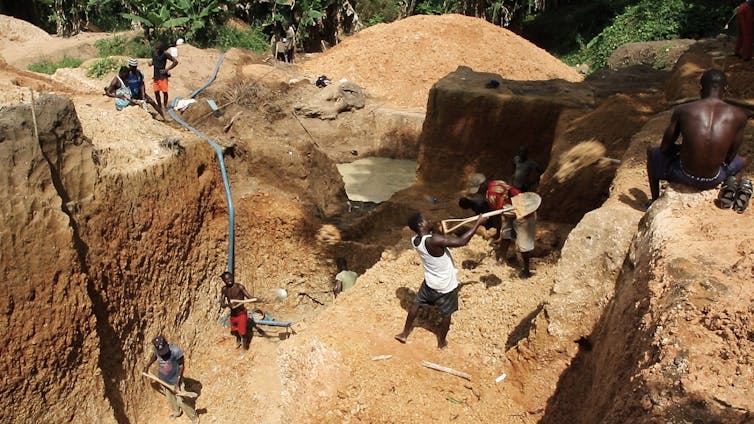How do diamonds move from the mine to the market, and who benefits from this trade? Research from Roy Maconachie, Reader in International Development at the University of Bath, powerfully captured in a short film, suggests that in Sierra Leone, it's the international traders rather than the local communities where the diamonds are mined who are the real winners. This article was originally published on The Conversation.
Ever since diamonds were discovered in Sierra Leone in the 1930s, they have had a significant impact on the country – socially, politically and economically. This is partly to do with how they are extracted from the ground.
In countries in southern Africa, diamond mining is mostly undertaken by large-scale, mechanised companies, which monitor and control deep reserves. But in Sierra Leone, diamonds are more commonly dispersed close to the surface of river beds. They can be found by anyone with a shovel and a sieve.
This accessibility has made Sierra Leone’s diamond-rich Kono district a magnet for migrant workers – mostly young, single, uneducated, unemployed men seeking their fortunes. World Bank estimates suggest the artisanal diamond mining sector is now Sierra Leone’s second largest employer (after agriculture), providing a livelihood for between 300,000 and 400,000 people.

Roy Maconachie and Simon Wharf, Author provided
Since 2003, I have been carrying out research in Kono, looking into the challenges of the diamond mining sector, and its problems of exploitation and poverty. My most recent project, funded by the US foundation Humanity United, aims to shed some light on the challenges of natural resource governance, and converting revenues into sustainable development.
Despite the non-mechanical and non-regulated nature of artisanal diamond extraction in Sierra Leone, there is still a tightly managed, highly ordered structure to production. Typically, gangs of labourers will work together in small areas, digging up gravel, and transporting and washing it. A different group of people will supply the miners with food and tools while they do this – but no payment will be offered unless diamonds are found.
This highly unequal relationship between diggers and “supporters” has led to serious concerns over the detrimental social impact of diamond mining in Sierra Leone. It has even been described as a “system of debt bondage and a contemporary form of slavery”. One local expert told me:
Everybody is doing business to maximise profit … [by suppressing] those that are below.
Yet the artisanal diamond mining sector still has an important role to play in driving local economic development in rural areas. It supports hundreds of thousands of poor people, supplying valuable start-up capital for other economic activities, and helping to nourish smallholder agriculture.
Generally, though, Sierra Leone’s wealth of natural resources – gold, iron ore, bauxite and rutile – has not translated into better living conditions for its people. In fact, the opposite has been true.
The United Nations Development Programme places Sierra Leone at the bottom of its Human Development Index. It is one of the world’s poorest nations and lags well behind most on social development.
Ravaged for years by war, and battered more recently by the Ebola crisis, economic development has come to a grinding halt through a combination of corruption, revenue mismanagement and misfortune.
Diamonds are clearly linked to Sierra Leone’s underdevelopment. Small, transportable and extremely valuable, they played a major role in funding the country’s brutal civil war of the 1990s. And the informal nature of the industry in Sierra Leone makes it easy for local communities to miss out on any related economic benefits.
Diamond mining remains one of Sierra Leone’s most lucrative export industries, with annual production of up to US$250m. But due to poor governance and widespread corruption, only a fraction of this wealth returns to the areas where diamonds are mined.
For richer, for poorer
While international traders reap vast rewards, poverty and hardship is the reality for many of those who actually find the diamonds. Many mining operations take place in remote locations outside the reach of government monitors, and in close proximity to the porous borders with Guinea and Liberia.
The unregulated nature of the artisanal mining sector means that many diamond diggers end up in exploitative relationships with buyers and middlemen. They become trapped in cycles of poverty and indebtedness. While some effort has been made to address this exploitation, and empower unregistered miners and their families at the bottom of the supply chain, more needs to be done. Some have argued that the keys to making the sector more sustainable are formalisation and better local governance.
Yet most mining activity still takes place informally – a situation driven by the many vested interests in the sector. Too many people are benefiting from the informal and unregulated conditions that currently exist.

Roy Maconachie and Simon Wharf, Author provided
If the government and policy-makers of Sierra Leone wish to address the poverty and inequality of diamond mining, a more nuanced understanding of the realities in these mining communities is needed.
Artisanal mining will likely remain a dominant industry in Sierra Leone for many years to come. But it is an industry which has always been characterised by exploitation and poverty.
![]() Addressing the challenges of local-level governance, and how power is exercised over diamond management and decision-making is vital. It is the only way to ensure that more of the wealth remains where it begins – in the communities where the diamonds are being mined.
Addressing the challenges of local-level governance, and how power is exercised over diamond management and decision-making is vital. It is the only way to ensure that more of the wealth remains where it begins – in the communities where the diamonds are being mined.
This article was originally published on The Conversation. Read the original article.
Header image by Roy Maconachie and Simon Wharf
Respond



